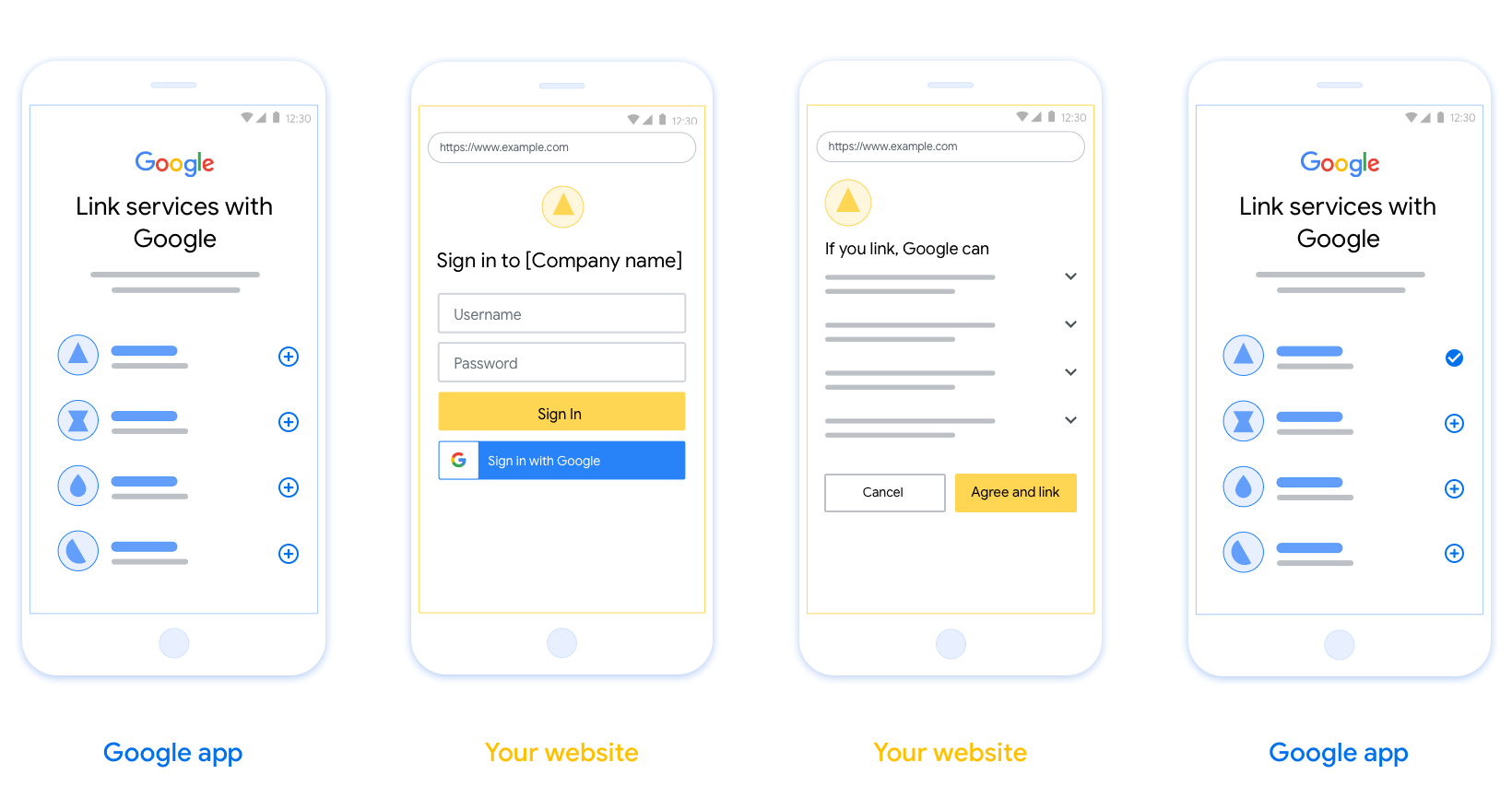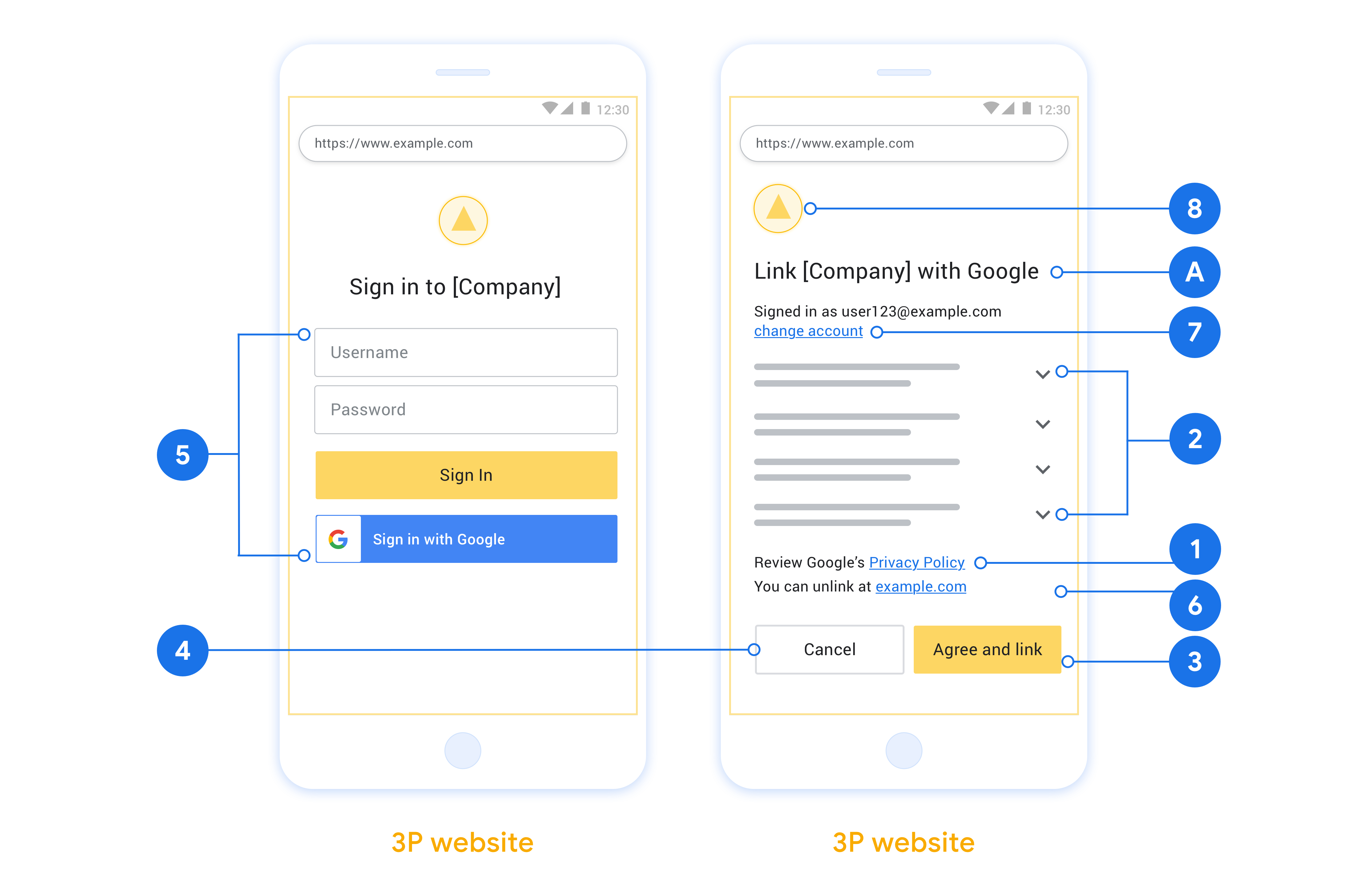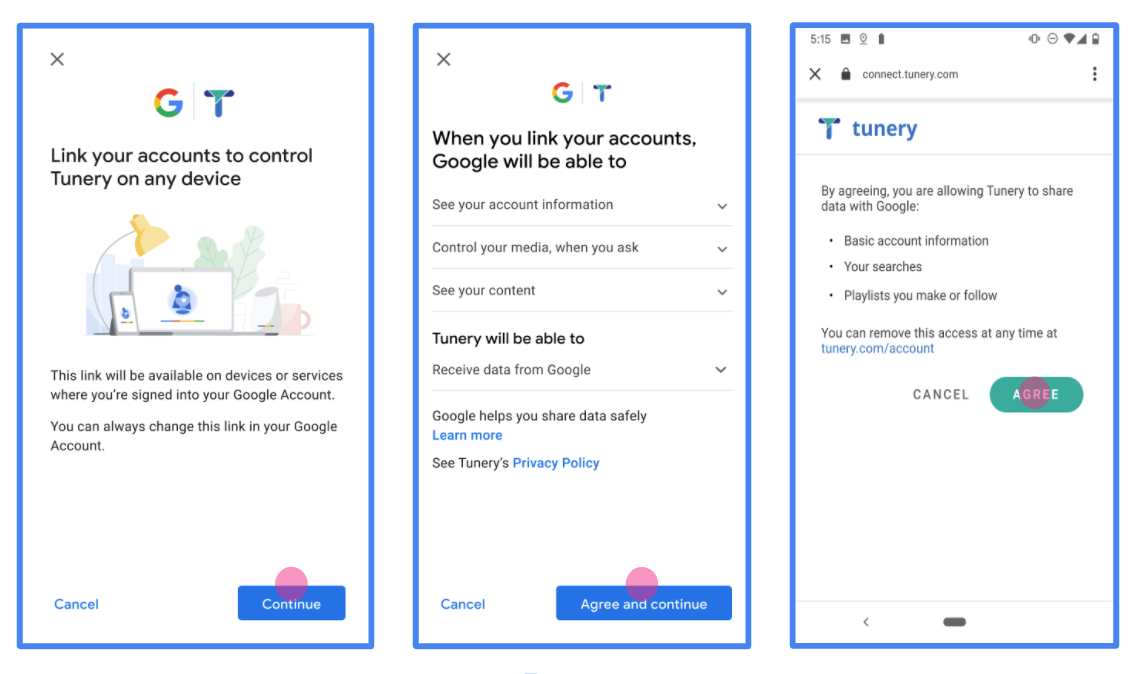帳戶連結會使用業界標準的 OAuth 2.0 隱含和授權碼流程。您的服務必須支援符合 OAuth 2.0 標準的授權和權杖交換端點。
在隱含流程中,Google 會在使用者的瀏覽器中開啟授權端點。成功登入後,會將長期存取權杖傳回 Google。這個存取權杖現在已納入 Google 發出的每項要求。
在授權碼流程中,您需要兩個端點:
授權端點,會為尚未登入的使用者顯示登入 UI。授權端點也會建立短效授權碼,記錄使用者對所要求存取權的同意聲明。
權杖交換端點,負責兩種交換:
- 交換授權碼用於長期更新權杖和短期存取權杖。使用者進行帳戶連結流程時,就會發生這個交換。
- 這個外掛程式能使用長期更新權杖做為短期存取權杖。 如果 Google 需要新的存取權存證,因為舊的存證已過期,就會發生此交換。
選擇 OAuth 2.0 流程
雖然隱含流程的實作方式較簡單,但 Google 建議隱含流程發出的存取權杖永遠不會過期。這是因為權杖過期後,系統必須要求使用者再次連結帳戶。如果您基於安全性考量而需要代碼到期,強烈建議您改用授權程式碼流程。
設計指南
本節說明針對 OAuth 連結流程所託管使用者畫面的設計需求和建議。Google 的應用程式呼叫後,您的平台會向使用者顯示登入 Google 頁面和帳戶連結同意畫面。使用者同意連結帳戶後,系統會將他們導向 Google 的應用程式。

需求條件
- 您必須說明使用者的帳戶將連結至 Google,而不是 Google Home 或 Google 助理等特定 Google 產品。
建議
建議您採取以下做法:
顯示《Google 隱私權政策》。在同意畫面加入 Google 隱私權政策連結。
要共用的資料。使用簡潔明瞭的表達方式,向使用者說明 Google 需要他們的哪些資料,以及原因。
明確的行動號召。在同意聲明畫面上明確列出行動號召,例如「同意並連結」。這是因為使用者需要瞭解自己必須與 Google 分享哪些資料,才能連結帳戶。
可取消訂閱。如果使用者選擇不連結,請提供返回或取消的選項。
清除登入程序。請確認使用者有明確的方法登入 Google 帳戶,例如使用者名稱和密碼欄位,或使用 Google 帳戶登入。
可取消連結。提供使用者解除連結的機制,例如平台上帳戶設定的網址。或者,您也可以加入 Google 帳戶的連結,讓使用者能管理已連結帳戶。
變更使用者帳戶的功能。建議使用者切換帳戶的方法。如果使用者傾向擁有多個帳戶,這項功能就特別實用。
- 如果使用者必須關閉同意畫面才能切換帳戶,請將可復原的錯誤傳送給 Google,方便使用者透過 OAuth 連結和隱含流程登入所需帳戶。
加入標誌。在同意畫面上顯示公司標誌。 請依照您的樣式規範放置標誌。如果您也想顯示 Google 的標誌,請參閱標誌和商標。

建立專案
如要建立專案以使用帳戶連結,請按照下列步驟操作:
- 按一下 [Create Project]。
- 輸入名稱或接受系統產生的建議。
- 確認或編輯其餘欄位。
- 點選「建立」。
如要查看專案 ID,請按照下列步驟操作:
- 在到達網頁的表格中找出專案。專案 ID 會顯示在「ID」欄中。
設定 OAuth 同意畫面
Google 帳戶連結程序會顯示同意畫面,告知使用者要求存取資料的應用程式、要求存取的資料類型,以及適用條款。您必須先設定 OAuth 同意畫面,才能產生 Google API 用戶端 ID。
- 開啟 Google API 控制台的「OAuth 同意畫面」頁面。
- 如果出現提示,請選取您剛建立的專案。
在「OAuth 同意畫面」頁面中填寫表單,然後按一下「儲存」按鈕。
應用程式名稱:要求同意的應用程式名稱。名稱應如實反映應用程式,且與使用者在其他地方看到的應用程式名稱一致。應用程式名稱會顯示在帳戶連結同意畫面上。
應用程式標誌:同意畫面上的圖片,可協助使用者識別您的應用程式。標誌會顯示在帳戶連結同意畫面和帳戶設定頁面。
支援電子郵件地址:方便使用者與您聯絡,洽詢同意聲明相關事宜。
Google API 的範圍:範圍可讓應用程式存取使用者的私人 Google 資料。如果是 Google 帳戶連結用途,預設範圍 (電子郵件、個人資料、openid) 就已足夠,不需要新增任何敏感範圍。一般而言,最佳做法是在需要存取權時,逐步要求範圍,而非預先要求。瞭解詳情。
授權網域:為保障您與使用者的安全,Google 只允許應用程式透過 OAuth 驗證,使用授權網域。應用程式的連結必須託管於授權網域。瞭解詳情。
應用程式首頁連結:應用程式的首頁。必須託管在授權網域。
應用程式隱私權政策連結:顯示在 Google 帳戶連結同意畫面上。必須託管在授權網域。
應用程式服務條款連結 (選填):必須代管於授權網域。

圖 1. 虛構應用程式 Tunery 的 Google 帳戶連結同意畫面
查看「驗證狀態」,如果應用程式需要驗證,請點按「送交驗證」按鈕,將應用程式送交驗證。詳情請參閱 OAuth 驗證規定。
實作 OAuth 伺服器
如要支援 OAuth 2.0 隱含流程,服務會進行授權 並可透過 HTTPS 存取端點這個端點會負責驗證 徵得使用者同意,才能存取資料。授權端點 為使用者提供未登入並記錄登入的登入使用者介面 同意授予請求的存取權。
當 Google 應用程式需要呼叫服務的其中一個已授權 API 時, Google 會使用這個端點,向使用者取得呼叫這些 API 的權限 管理。
由 Google 發起的一般 OAuth 2.0 隱含流程工作階段,是 下列流程:
- Google 會在使用者的瀏覽器中開啟授權端點。 使用者登入 (如果尚未登入),並將權限授予 Google 透過您的 API 存取他們的資料 (如果尚未授予權限)。
- 您的服務會建立存取權杖,並傳回給 Google。若要這麼做,請將使用者的瀏覽器重新導向回 Google,並授予存取權 附加至請求的權杖
- Google 會呼叫服務的 API,並將存取權杖附加至 每個要求您的服務會確認存取權杖是否已授予 Google 授權存取 API,然後完成 API 呼叫。
處理授權要求
Google 應用程式需要透過 OAuth 2.0 進行帳戶連結時 隱含流程時,Google 會將使用者傳送至您的授權端點, ,其中包含下列參數:
| 授權端點參數 | |
|---|---|
client_id |
您指派給 Google 的用戶端 ID。 |
redirect_uri |
您傳送回應到這項要求的網址。 |
state |
傳回給 Google 的記帳金額,值維持不變 重新導向 URI |
response_type |
要在回應中傳回的值類型。以 OAuth 2.0 隱含
回應類型則一律為 token。 |
user_locale |
中的 Google 帳戶語言設定 RFC5646 將內容翻譯成使用者慣用的語言。 |
舉例來說,如果您的授權端點位於
https://myservice.example.com/auth,要求可能如下所示:
GET https://myservice.example.com/auth?client_id=GOOGLE_CLIENT_ID&redirect_uri=REDIRECT_URI&state=STATE_STRING&response_type=token&user_locale=LOCALE
如要讓授權端點處理登入要求,請按照下列步驟操作: 步驟:
確認
client_id和redirect_uri的值如下: 防止授予非預期或設定錯誤的用戶端應用程式存取權:- 確認
client_id與您用戶端 ID 相符 而是指派給 Google - 確認
redirect_uri指定的網址 參數的格式如下:https://oauth-redirect.googleusercontent.com/r/YOUR_PROJECT_ID https://oauth-redirect-sandbox.googleusercontent.com/r/YOUR_PROJECT_ID
- 確認
檢查使用者是否已登入您的服務。如果使用者未簽署 的登入或申請流程。
產生供 Google 存取 API 的存取權杖。 存取權杖可以是任何字串值,但必須明確代表 以及該權杖適用的用戶端,且不可猜測。
傳送 HTTP 回應,將使用者的瀏覽器重新導向至網址 由
redirect_uri參數指定。包含所有 網址片段中的下列參數:access_token:您剛剛產生的存取權杖token_type:字串bearerstate:原始資料中未經修改的狀態值 要求
以下是最終網址的範例:
https://oauth-redirect.googleusercontent.com/r/YOUR_PROJECT_ID#access_token=ACCESS_TOKEN&token_type=bearer&state=STATE_STRING
Google 的 OAuth 2.0 重新導向處理常式收到存取權杖並確認
state 值未變更。Google 取得
服務存取權杖,Google 會將該權杖附加到後續的呼叫
以便將 API 新增至 Service API
處理使用者資訊要求
userinfo 端點是 OAuth 2.0 受保護的資源,可傳回已連結使用者的聲明。除了下列用途外,不一定要實作並代管 userinfo 端點:
成功從權杖端點擷取存取權杖後,Google 會向您的使用者資訊端點傳送要求,以擷取已連結使用者的基本個人資料。
| userinfo 端點要求標頭 | |
|---|---|
Authorization header |
Bearer 類型的存取權杖。 |
舉例來說,如果您的 userinfo 端點位於
https://myservice.example.com/userinfo,要求可能如下所示:
GET /userinfo HTTP/1.1 Host: myservice.example.com Authorization: Bearer ACCESS_TOKEN
為了讓 userinfo 端點處理要求,請按照下列步驟操作:
- 從授權標頭擷取存取權杖,然後為與存取權杖相關聯的使用者傳回資訊。
- 如果存取權杖無效,請使用
WWW-Authenticate回應標頭傳回 HTTP 401 Unauthorized 錯誤。以下是 userinfo 錯誤回應的範例:HTTP/1.1 401 Unauthorized WWW-Authenticate: error="invalid_token", error_description="The Access Token expired"
如果存取權杖有效,則傳回並傳回 HTTP 200 回應,且 HTTPS 內文含有下列 JSON 物件 回應:
{ "sub": "USER_UUID", "email": "EMAIL_ADDRESS", "given_name": "FIRST_NAME", "family_name": "LAST_NAME", "name": "FULL_NAME", "picture": "PROFILE_PICTURE", }userinfo 端點回應 sub用來在系統中識別使用者的專屬 ID。 email使用者的電子郵件地址。 given_name選填:使用者的名字。 family_name選填:使用者的姓氏。 name選填:使用者全名。 picture選用:使用者的個人資料相片。
驗證實作
您可以使用 OAuth 2.0 Playground 工具驗證實作結果。
請在工具中按照下列步驟操作:
- 點選「Configuration」圖示 ,開啟 OAuth 2.0 設定視窗。
- 在「OAuth 流程」欄位中,選取「用戶端」。
- 在「OAuth 端點」欄位中,選取「自訂」。
- 在對應的欄位中指定 OAuth 2.0 端點,以及您指派給 Google 的用戶端 ID。
- 在「步驟 1」部分中,請勿選取任何 Google 範圍。請改為將這個欄位留空,或輸入有效的伺服器範圍 (如果您不使用 OAuth 範圍,則輸入任意字串)。完成後,按一下「授權 API」。
- 在「步驟 2」和「步驟 3」部分,請完成 OAuth 2.0 流程,並確認每個步驟都能正常運作。
您可以使用 Google 帳戶連結示範工具驗證實作成果。
在工具中執行下列步驟:
- 按一下「使用 Google 帳戶登入」按鈕。
- 選擇要連結的帳戶。
- 輸入服務 ID。
- 您可以選擇輸入一或多個要申請存取權的範圍。
- 按一下「開始試用」。
- 系統顯示提示時,請確認您可以同意或拒絕連結要求。
- 確認系統是否會將你重新導向至平台。
